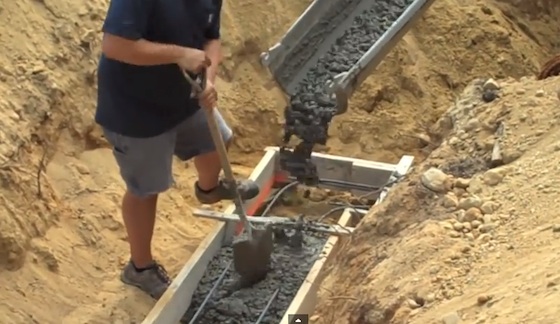Concrete Footer Quick Start Guide
Concrete Footer Quick Start Guide
DEGREE OF DIFFICULTY: 
I’m embarrassed to say I can’t remember my first footer. Pouring concrete down in a trench or a hole is not quite like your first kiss, that’s for sure!
All I can tell you it was many years ago. I do remember many of the footers I dug and poured and some of them were quite the experience!
The last major footer I poured was on a cold rainy day with my good friend Matt Motz. He needed my help to build the foundation for his sugar shack - a traditional building where he boiled maple sap transforming it into blue ribbon award-winning golden maple syrup.
He and I alone poured a fairly large trench footer with no issues because we were prepared and I had thought everything through. You’re going to have the same success because I’m going to share my experience with you!

I’ve rated this guide four hammers out of five because pouring footers is by no means a rookie task. It’s hard work, you need to know some math, and you have to work with reinforcing steel. No one thing is hard, but add them all together and it’s a tough, but doable job. If I don’t stop thinking about it, I may rank it five hammers!
The biggest challenges when pouring footers is getting the heavy concrete into the forms or trench with the absolute minimum amount of work. That’s followed closely by getting the footer level.
You may not be able to get the concrete truck close to the excavation. Small machines you rent to haul the concrete may break down halfway through the pour. Wheelbarrows can tip over. There are all sorts of things that can go wrong.
You need to plan for all of this. You need to be prepared and have extra help when the concrete truck arrives. You’ll never regret having too many people, too many shovels, too many wheelbarrows, etc.
Watch the video below unless you’ve come here from YouTube having already watched it.
Be sure to look at the RELATED CONTENT links at the bottom of this page. Lots of goodies there for you.
REQUIRED TOOLS & MATERIALS:
 |
|
|||
| |
 |
|||
| |
 |
|||
| |
|
|||
| |
|
TIPS
- STOP - Understand that concrete is very alkaline and it can cause severe burns to your skin. WASH OFF CONCRETE from skin immediately - Voice of experience talking.
- Wear rubber boots if walking/working in wet concrete. Concrete will RUIN leather work boots eating away at the stitching.
- Concrete is HEAVY. A cubic yard weighs nearly 4,000 pounds. A wheelbarrow full of it will kick your butt.
- Trench footers require you to be in the trench pouring in many instances. This is hard. You’re stepping around the steel rods.
- Create level points in the trench footer by driving rebar into the soil to the height you want the footer concrete. Put these points every 4 or 6 feet and screed to them.
- Flat and level footers make it VERY EASY to install concrete block or poured concrete foundation forms. Unlevel or humpy footers will cause wailing and gnashing of teeth.
- Footers need to be poured on solid ground. If the soil is weak, contains organics, stinks like a swamp, is bluish/black stinky clay, you’ll probably have a future foundation failure. If you don’t know to judge good vs. bad soil, then call in a pro foundation man and pay him to tell you.
- Footers need reinforcing steel. Install no less than #4 bars. Suspend the steel so at least 4 inches of concrete is UNDER the steel.
- Lap reinforcing steel on long runs at least 16 inches. If you don’t lap it, the concrete will crack where you butt pieces together.
- Footers poured with 2x form boards are the easiest to do. You typically have room to work around the footer and you can use a board to screed the concrete across the top of the form boards.
- If the form boards are installed LEVEL, your footer will come out perfect.
- Footers need to be SQUARE. Watch my video about how to Square Things.
- Footer concrete can be ordered at 3500 PSI strength. It can even be ordered at 3000 PSI strength in some cases.
- Installing a keyway in the wet footer concrete is not a bad idea, but vertical steel bars every 16 inches work well too.
- Celebrate your Victory!
Please subscribe to my Newsletter and get insider information on the latest home-improvement tips, and products. I guarantee you that my newsletter WILL save you time and money. Frequently, I include your questions with my answers and proposed solutions. Perhaps the best part of the newsletters are my reviews of new products based on my own testing. Click here to read my past newsletters.
It is FREE & EASY.
RELATED HELPFUL CONTENT:
- Foundation Footer
- Connecting a New Foundation to an Old One
- Step Footing
- Concrete Footer Part 2 Video
- Contractor Hiring Guides (use promo code EB20 for 20% off)
Column QSG017
One Response to Concrete Footer Quick Start Guide